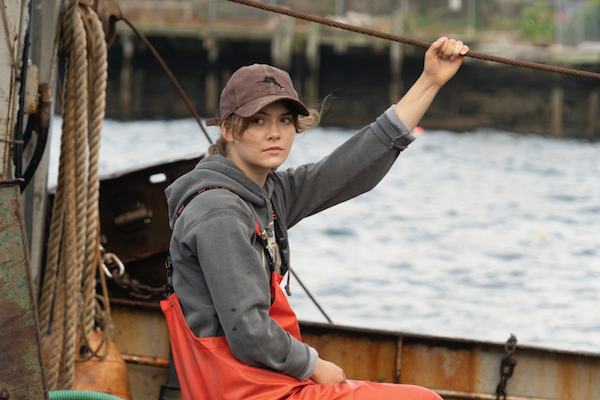Movie review by Greg Carlson
Writer-director Siân Heder steers “CODA” through the treacherous shoals of cinematic cliche, drawing on a deeply talented cast and a strong command of world-building verisimilitude. Since the film’s debut at the virtual 2021 Sundance Film Festival, where it received a quartet of awards, critics and early viewers have sustained a steady level of buzz ahead of wider release. Scooped up by Apple for a Sundance record 25 million dollars, “CODA” — which doubles in meaning as an acronym for a child of deaf adults and the musical designation for a concluding passage — is crowd-pleasing, tear-jerking, and feel-good in the best senses of those often suspect descriptions.
Heder reworks Éric Lartigau’s 2014 film “La Famille Bélier,” swapping a rural farm operation for a working-class Massachusetts fishing vessel. In both the original and the remake — which owe some debt to the 1996 German film “Beyond Silence,” directed by Caroline Link — a teenager interested in studying music faces a difficult decision between personal dreams and the obligations and responsibilities of providing continued support to the family livelihood. And even if you think you’ve seen this basic conundrum a hundred times before, Heder puts her movie together with enough attention to detail and specificity to stand out from the crowd.
The English actor Emilia Jones, best known for her work in the Netflix series “Locke & Key,” plays Ruby Rossi, daughter of deaf parents Jackie (Marlee Matlin) and Frank (Troy Kotsur) and sister of deaf sibling Leo (Daniel Durant). Heder, who relied on the input of collaborators Alexandra Wailes and Anne Tomasetti as her self-described “ASL masters,” exhibits a desire to avoid essentializing or exoticizing the non-hearing characters in the story. And her work pays off. Even though the comic juxtapositions — more often than not of a sexual nature — can be as broad as the side of a barn, the familial conflicts on the flip side of the coin resonate with hard truths.
“La Famille Bélier” received some pointed criticism for casting actors who could hear as the deaf parents of the protagonist. And Matlin threatened to leave “CODA” when producers considered casting non-deaf performers as deaf characters (a disappointing but unsurprising example of the film business’s shortsighted adherence to the bottom line). I believe that one could mount a successful argument that “CODA” is less audist than a film like Myroslav Slaboshpytskiy’s “The Tribe,” even if both works are made and sound-designed principally for hearing audiences (by hearing filmmakers).
Obviously, “The Tribe” and “CODA” are worlds apart in terms of genre. But despite the acclaim, there is something to ponder in the argument posited by Rebecca Atkinson in her original review of “La Famille Bélier” that questions why “Deaf people’s culture and experiences have long been appropriated for the fascination and entertainment of others” even as few films have been made by deaf directors. Additionally, Atkinson points to the potentially misplaced fascination hearing people exhibit toward stories exploring the “relationship between music and deafness.”
Despite these legitimate questions that could and should invite additional dialogue, “CODA” is a profoundly moving and highly recommended film.
